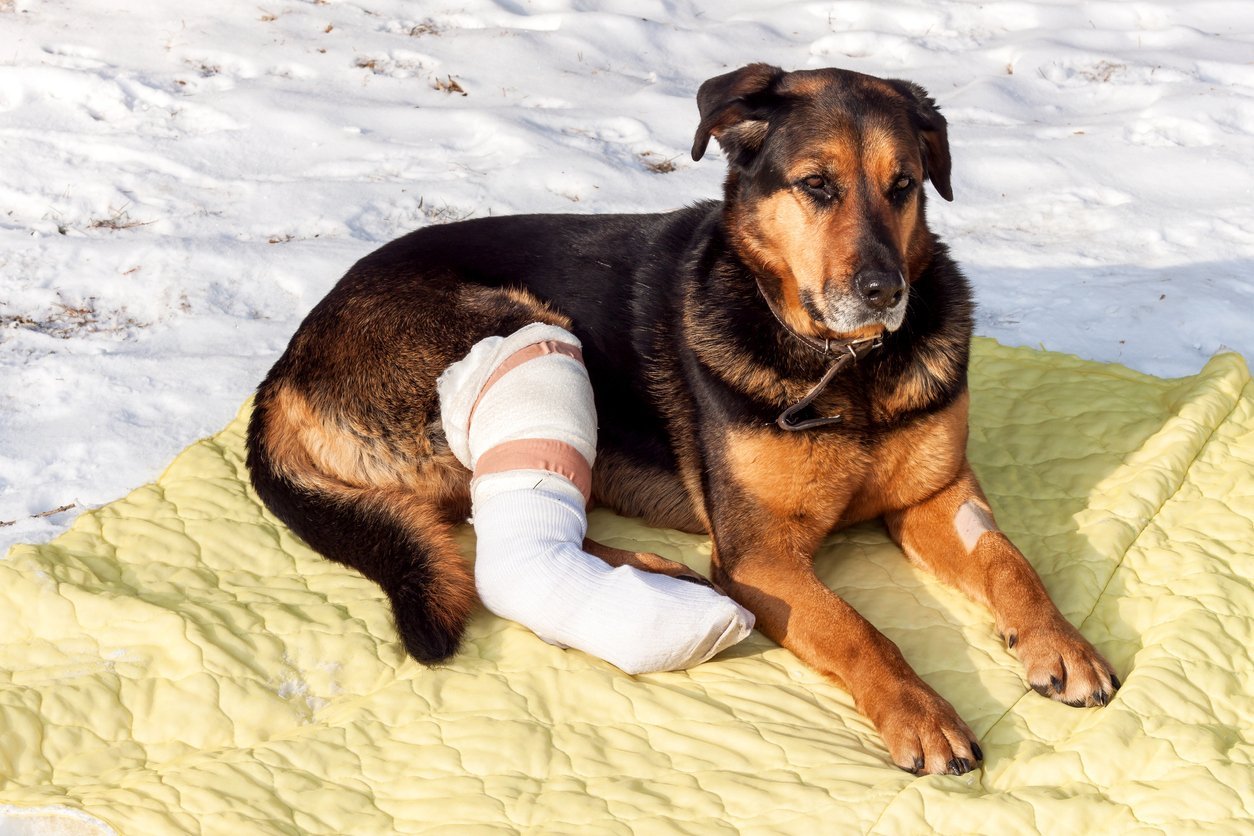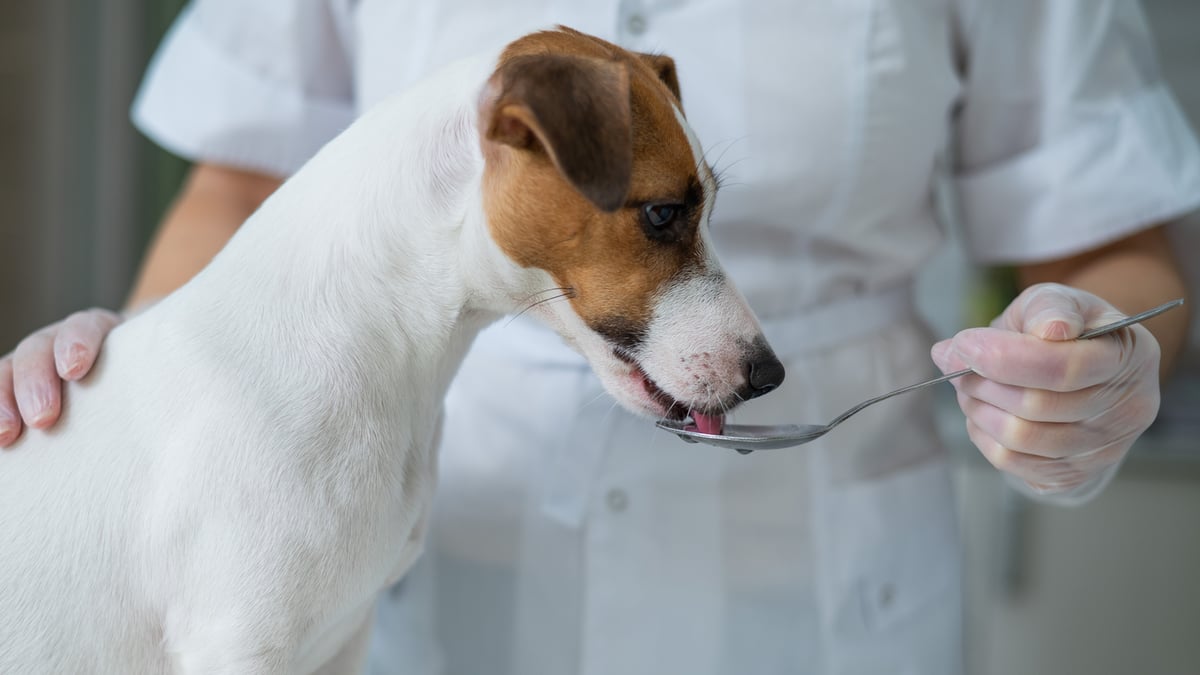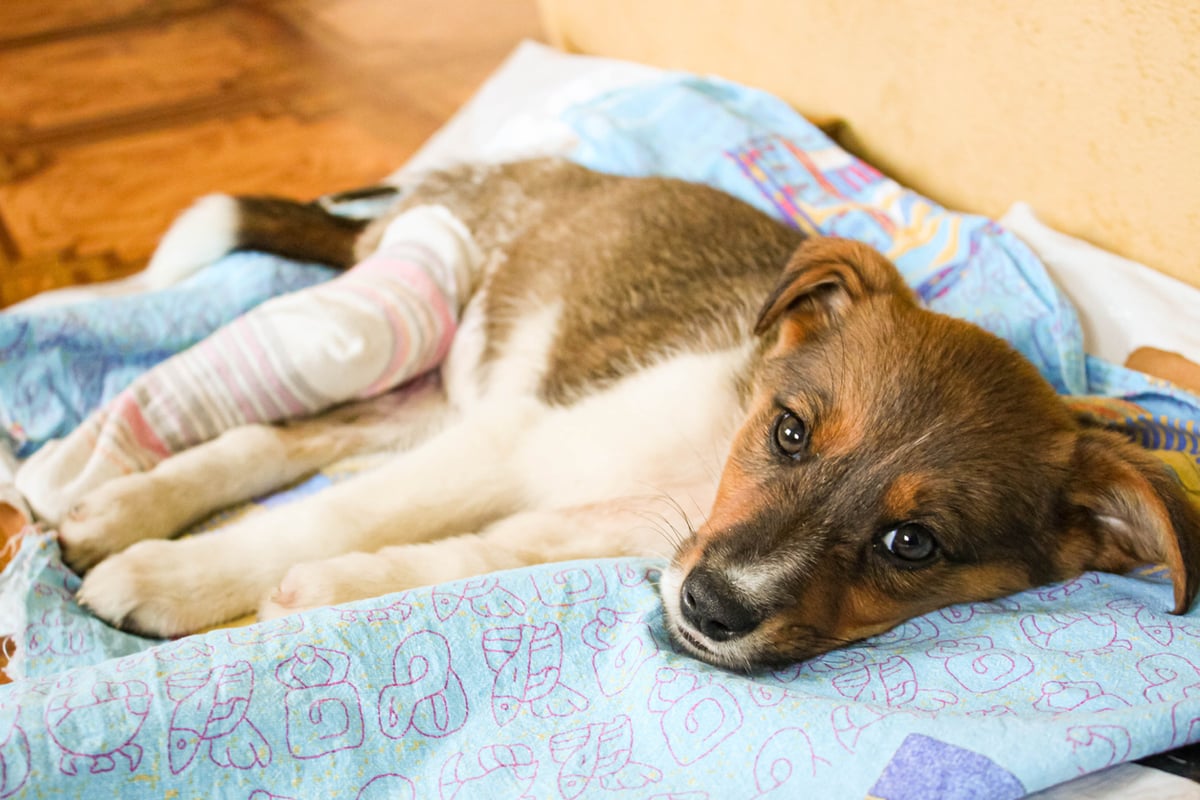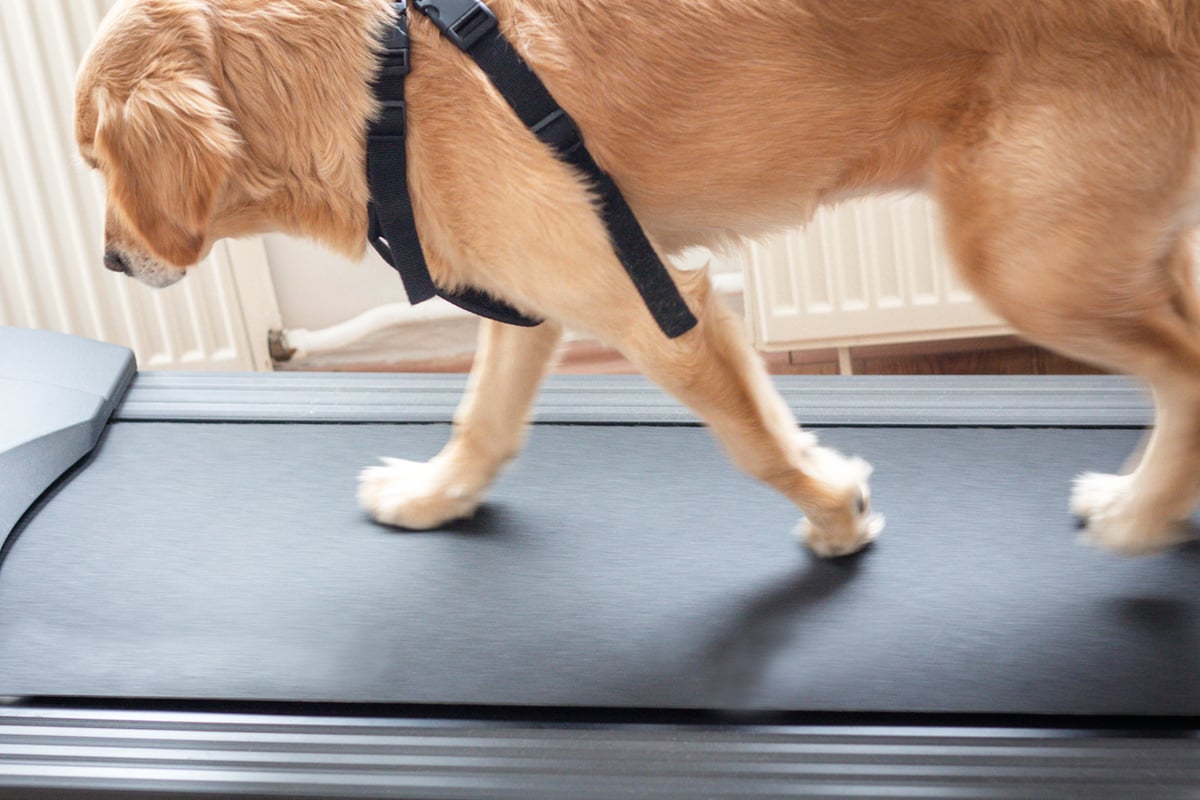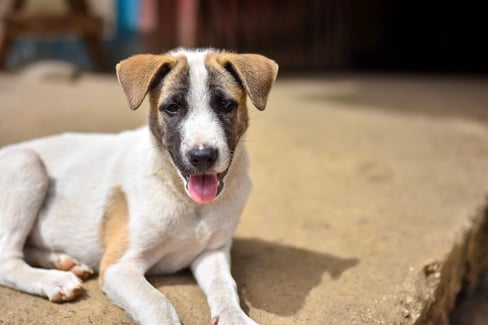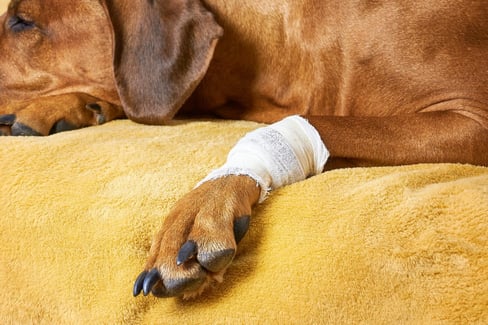Table of Contents
You’re running in the park, playing fetch with your dog, when suddenly, your little furball is wincing in pain, no longer able to grab the frisbee from midair. They’ve been struck by an all too familiar, painful problem — a dog ACL tear.
A dog torn ACL can spell disaster for any dog, especially the particularly active canines out there. The canine ACL, also known as the cranial cruciate ligament or CrCL, is the most important stabilizer inside the canine knee (stifle) joint. So it’s no wonder that we’re so worried about protecting our dogs from this painful dog front leg injury.
In this post, we’re going to break down the facts on a torn ACL on a dog, as well as get into the ways you can prevent an ACL dog injury, and of course what to do if your precious pup experiences a dog torn ACL.
Woof out further ado, let’s get into it!
What Does a Torn ACL on Dog Look Like?
You need to know what to look for when it comes to a torn ACL in a dog. That way, you can make sure your pup’s discomfort is as short as possible.
But before we can get to the symptoms, you need to know a little bit about dog anatomy.
Between the femur and tibia bones is a cartilage-like structure called the meniscus. This ligament serves numerous purposes in the joint, including shock absorption and positional sensing. When it’s ruptured, it can cause serious injuries.
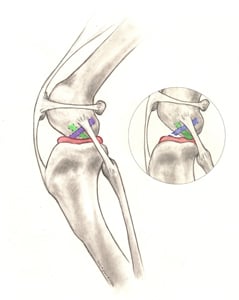
In the diagram above, the purple highlighted area is the cranial cruciate ligament (CrCL), also known as the ACL. the red highlighted area is the meniscus, and the green highlighted area is the caudal cruciate.
The first image shows a complete, uninjured CrCL. The second image shows what happens to a dog with an ACL tear: the displaced shinbone then crushes the meniscus, making for a painful situation for your dog.
Canines of any size, breed, or age can be affected by cranial cruciate ligament disease. There is evidence that some breeds, including Newfoundlands and Labrador Retrievers, are genetically predisposed to the condition, while others, such as Dachshunds and Basset Hounds, are less likely to be affected.
The following breeds are known to have a higher incidence of dog torn ACLs:
- Rottweiler
- Newfoundland
- Staffordshire Terrier
- Mastiff
- Akita
- Saint Bernard
- Chesapeake Bay Retriever
- Labrador Retriever
Symptoms of Torn ACL in Dogs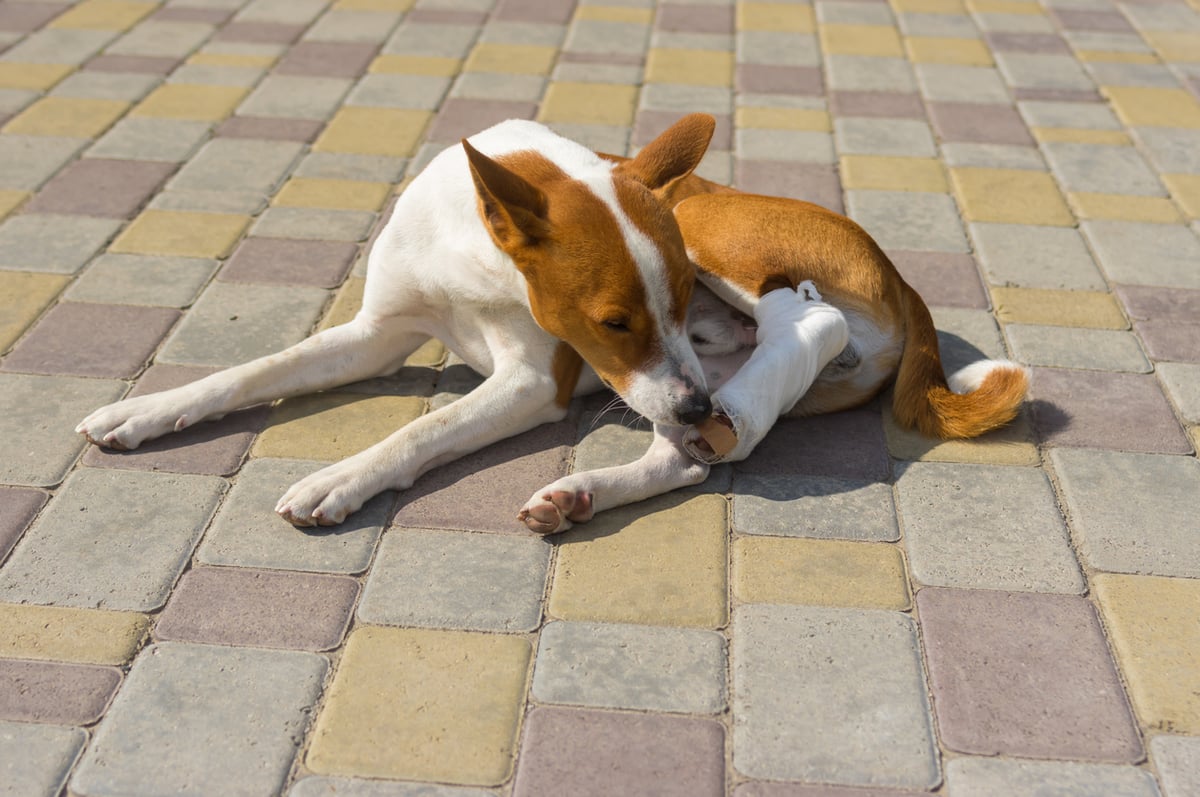
If your pup is unfortunate enough to have to deal with a dog torn ACL, then it will likely be obvious to you, especially in acute cases.
There are, however, a couple of key dog tearing ACL symptoms you should be aware of in case your dog is suffering from this condition:
1. Dog Lameness
A lame dog is often a sign that you’ve got a pup with a torn ACL on your hands. That’s especially true if your pup is usually happy to romp and roam about and the lameness has come on suddenly. If you notice your dog is unusually immobile or cannot rise from a seated position easily, you could be dealing with a torn ACL.
2. Dog Limping
Another sign that your dog could have a torn ACL is if you observe dog limping. This looks like hobbling along and lifting the affected leg in the air. If your dog is suffering from an acute case of a torn CrCL, you may also hear a popping sound as the ligament ruptures, so always keep a close eye and ear on your pup while he’s moving about.
3. Muscle Atrophy
Muscle atrophy simply refers to the wasting away or thinning of muscle tissue. Muscle atrophy usually comes with its own symptoms, such as:
- Weight loss
- Weak, soft, or flabby muscles
- Unbalanced gait
- Loss of coordination
- Weakness in your dog’s limbs
If you spot any of these problems rearing their head in your dog, you could be dealing with muscle atrophy. If you notice your pup has signs of muscular atrophy in one of its legs, heading to the vet can help you determine whether a torn ACL is the cause of your pup’s muscle atrophy.
4. Swelling
Another indicator that your dog is dealing with a torn ACL is if you notice swelling in your pup’s knees. Pay attention to your dog’s limbs, and if you notice that one seems larger than the other or is warm to the touch, you could be dealing with swelling that indicates a torn ACL.
5. Inability to Bear Weight
The inability to bear weight on the affected leg can be another sign that your pooch has a torn ACL. Remember, if you see your dog suddenly limping on back leg or front leg, there’s a chance that the cause of the limping is due to a torn ACL. You’ll want to get your pup checked out to determine if a torn ACL is the cause of the limping, and so your pup can receive treatment.
6. Decrease in Activity
A decrease in activity can also be an indicator that your pup has a torn ACL. Because a torn ACL can be painful and limit movement, your dog may be less likely to romp and roam around. If he seems to be more lethargic than usual, it pays to get him checked out to ensure that a torn ACL isn’t what’s causing his lethargy.
Call your vet immediately if you spot any of the signs of a dog with ACL injury as this is a serious and painful injury, and you wouldn't want your pup to suffer any more than they have to.
How Does a Dog Tear Their ACL?
A dog tears their ACL in several different ways. It can be either caused by sudden, acute trauma or long-term degeneration caused by secondary factors like aging, dog arthritis, and obesity.
Canines can experience varying degrees of ACL issues, including partial tears as well as a completely ruptured ACL in dogs.
Common Cause #1: Acute Trauma
Your dog could be running around the backyard, happy as can be, and the next thing you know, they are crying out in pain. Instances where a dog has a sudden torn ACL can look like this.
Acute trauma leading to a dog torn ACL is thankfully the least common way dogs end up with this devastating injury. It is still possible, however, for your pup to experience dog torn ACL this way.
Specifically, the following criteria can make a dog torn ACL more likely:
- Athletics: Competing in sports like agility
- Age: Young dogs
- Activity level: Inactive dogs who suddenly undertake intense physical activity
A dog can hyperextend their stifle, and possibly tear their ACL, by participating in sports like agility. Hyperextension is an excessive internal rotation of the tibia when the joint is partially flexed. This may occur due to running while planting the hind limbs as the body continues forward. Ouch!
Your pup can make a sudden movement that ends in a dog torn ACL like:
- Misstep
- Fall
- Mid-air twist
- Sudden wrench or change in direction
Common Cause #2: Degenerative
The other scenario where your dog is likely to suffer from a torn CrCL is the much more likely one.
The dog's ACL can weaken through slow degeneration, unlike a human's. When the ligament is degraded, doing something as simple as walking around the block can cause the ligament to give out.A dog's ACL usually tears after years of arthritis developing in their knees, which is why it's so common for them to blow out both knees within a few years of each other.
Poor physical condition and excess weight raise the risk of dog ACL injuries. The good news is that pet owners can influence both of these factors. It's important to keep your dog’s body mass lean by exercising consistently and watching what your pup eats.
Dog ACL Tear Diagnosis 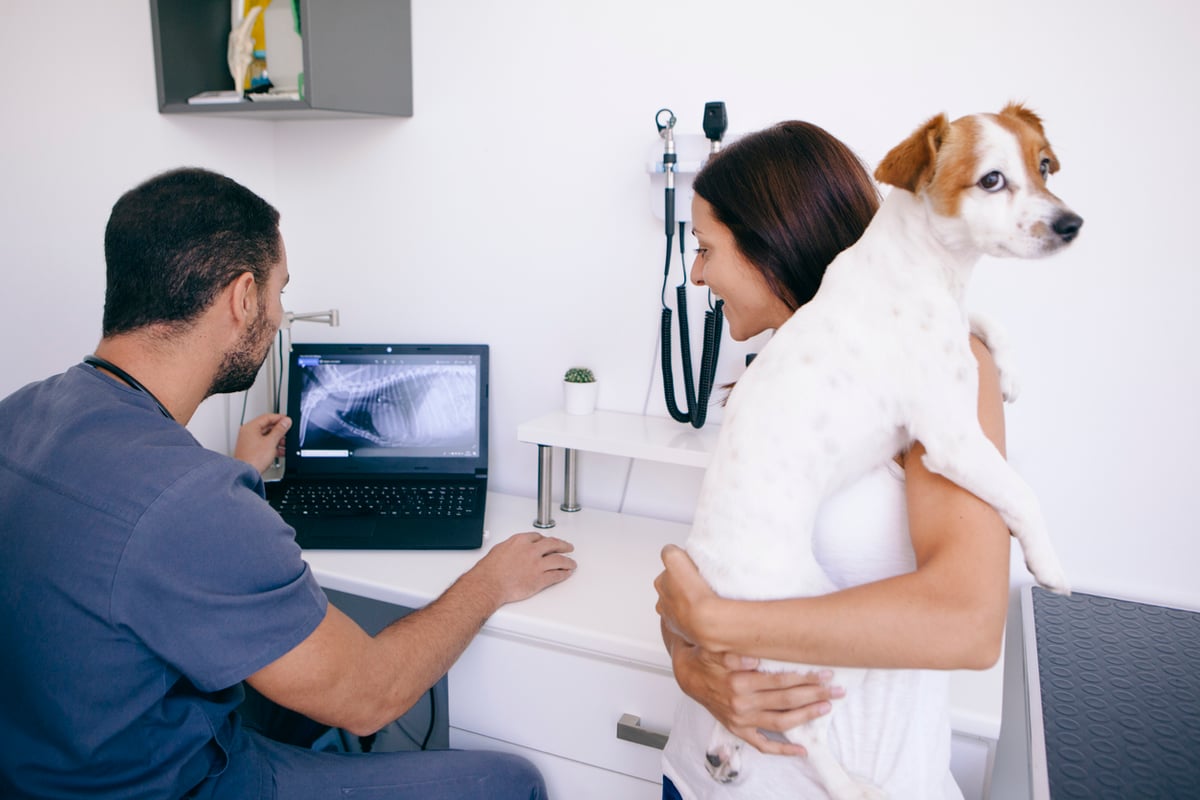
Whether you’ve got an ACL tear in dog hind leg or front leg, your veterinarian will complete a diagnosis by observing its gait, physical examination, and taking x-rays.
Your vet can see a few things from dog torn ACL X Rays:
- Potentially swollen joints and increased joint fluid
- Arthritis, and the severity of it
- What’s needed for surgery preparation
- Other conditions or causes of the pain
When a dog experiences a partially torn ACL, it can be trickier for your vet to diagnose the problem, as it is not as immediately obvious as a total rupture. A veterinarian will use specific techniques to assess the area, like the 'cranial drawer test' and the 'tibial compression test'. These tests can confirm abnormal motion in the knee, which is consistent with a CrCL rupture.
ACL Dog Injury Prevention Tips
We always want to try our best to prevent our pups from pain. So it only makes sense you’re searching for ways to prevent this painful injury.
In this section, we will break down the most important things to know about preventing a dog torn ACL, as well as provide you with some actionable insights into what you can do for your dog.
1. Incorporate a Supplement
While there is no one way or any guarantee you won’t experience a torn ACL on a dog, you can do your best to make your pup’s joints and soft tissues remain strong and healthy.
And how do you do that?
You incorporate a joint supplement, of course!
Joint supplements like TRI-ACTA and TRI-ACTA H.A help build strong joints, soft tissues, and ligaments, including the CrCL.
TRI-ACTA is a great preventative joint supplement you can give your dog from puppyhood onwards. If your dog isn’t predisposed to joint issues and you just want to support their overall joint health, TRI-ACTA is a great choice. Glucosamine for dogs, chondroitin, and MSM are the essential ingredients that make up this supplement.
If your dog has already experienced a joint issue like a torn ACL or is predisposed to joint issues, then TRI-ACTA H.A. is a stronger joint supplement that you can give them. It has all the ingredients in TRI-ACTA but with the addition of hyaluronic acid. This acid helps to further lubricate the joints by strengthening the viscosity of the synovial fluid in your dog’s joints, helping to prevent a torn ACL in dogs.
TRI-ACTA H.A. for Pets
Our maximum strength formula is optimally designed to accelerate the formation of cartilage, minimize inflammation, expedite the healing process, and improve joint conditions.

Setting your dog up for success with a joint supplement before they ever encounter an acute torn dog ACL or before joint degradation sets in means they will have stronger, more elastic joints that support active lifestyles. With healthier joints and ligaments, your dog can run free, and you can worry less about the ruff outcomes of a dog with torn ACL faces.
In the table below, you can find what key ingredients you should look for when reading a joint supplement label so you know exactly what your pup needs to prevent a dog torn ACL.
| Joint Health Ingredient |
Benefit |
| Glucosamine |
Aids in the production of proteoglycans, which is necessary for cartilage repair |
| MSM |
Reduces joint pain and inflammation |
| Chondroitin |
Prevents cartilage from degrading |
| Hyaluronic Acid |
Improves the viscosity of the synovial fluid, making joints more lubricated and mobile |
2. Exercise Carefully
The best way to avoid the pain of a dog torn ACL is to play it safe when you’re getting active with your pup.
Dogs need anywhere from 30 minutes to 2 hours a day of exercise. It all depends on their age, breed, and health status. For example, a young dog from an energetic breed may need more than a senior with arthritis. Talk to your vet if you aren’t sure about the best approach to maintaining dog muscle for your canine companion.
Ensure you give your dog regular exercise but in manageable doses. What we’re saying here is don’t take your couch potato out on Saturdays for a 3-hour hike, and if you do have an active pup, be sure to offer them a gentle warm-up when you head out. You should also avoid tossing balls and frisbees high in the air so they don’t wrench suddenly as they jump to grab it. For puppies, taking several short walks throughout the day is a better option than going for one long walk, as this can be too stressful for their growing body.
The table below outlines some exercises you use to condition your furball for the best chances of preventing a dog torn ACL.
| Type of Exercise for Preventing Dog Torn ACL |
Description |
| Walks |
|
| Underwater Treadmill |
|
| Swimming |
|
| Indoor games |
|
3. Watch Weight
When your canine bears more weight on their joints, they have an, unfortunately, higher likelihood of developing a dog torn ACL. The extra weight simply puts them at greater risk of developing arthritis, but it also can mean they are in poorer shape and can result in an unexpected, acute torn ACL when they're getting active.
You can help reduce the chances of your dog developing obesity, and therefore, an ACL tear, by providing them with a weight-management plan.
A plan to reduce weight to prevent a torn dog ACL should include:
- Not overfeeding treats or food
- Rewarding them with low-calorie treats
- Measuring how much food they eat
- Controlling weight with specific diets, such as the raw food diet
- Consulting your vet for additional assistance
- Creating a regular exercise regimen
4. Keep Up with Vet Visits
No one likes going for a checkup, especially our dogs.
But in order to best prevent dog anterior cruciate ligament injury, regular visits to the vet are in order.
Regular checks on the condition of their knees can catch a partial rupture of the ligament and early signs of arthritis in your dog that can later lead to a full dog torn ACL. These visits are also important for monitoring other health conditions and things like your dog’s weight, so if a problem is on the horizon, you and your vet can work together to create a solution.
A veterinarian will conduct a full physical examination of your dog during an annual wellness exam. The veterinarians will examine the heart and lungs, the eyes, ears, and look for fleas. Any vaccinations are also updated. Your veterinarian may offer suggestions regarding your pup's nutrition and dental care or suggest specific activities and medications based on their health needs after they've done a full inspection.
How to Treat Torn ACL in Dog
If you’re wondering how to treat a torn ACL in a dog, you’re in the right place. Dog ACL injuries are common and, thankfully, highly treatable. There are tools for a mild or partial torn ACL in dogs that can help support rehabilitation, and surgery is the primary tool for restoring the limb to its proper function.
X-Ray
When it comes to treating torn ACL in dogs, the first step is typically to conduct an x-ray. An x-ray will help the vet better understand what’s going on in your dog’s limb and can help him make a full diagnosis.
What’s interesting about the X-ray is that it doesn’t actually show the torn ACL since this is a muscle. However, it can show the consequences of the tear, making it easier for vets to make a proper diagnosis.
Brace
While a dog torn ACL brace isn’t usually a replacement for surgery, it can be paired with surgery. These braces help stabilize your dog’s knee and provide extra support to your pup.
The brace is often meant to be worn before and after surgery. This not only helps prepare your pup for his operation, but it can also help speed up his recovery after the surgery has been performed. That will help him get back on their feet and to their usual self in no time!
Surgery
A torn ACL in a dog is typically treated with surgery as it is the only way to permanently fix the instability in the knee joint. Surgery fixes one of the main issues associated with a dog ACL injury — knee instability and pain caused by the loss of the ligament structure support.
This surgery isn't about "repairing" a torn ACL on dogs. As a result of biological and mechanical factors, the ligament cannot heal once it tears, no matter how severe. Canine CrCLs aren't replaced with grafts like humans' are, either.
Dogs' knees are different mechanically from human knees, so graft-based techniques aren't as reliable for treating a dog with an ACL tear as they are for their bipedal counterparts.
Several surgical treatment options are available for treating a dog torn ACL, as outlined in the table below.
| Type of Dog ACL Rupture Surgery |
Description |
| Tibial Plateau Leveling Osteotomy (TPLO) |
|
| Lateral Suture Technique or Extracapsular Repair |
|
| Tibial Tuberosity Advancement (TTA) |
|
If meniscal damage is present at the same time as a dog ACL tear, your surgeon will remove the damaged meniscus parts when stabilizing the knee.
Which procedure and how much additional surgery is done to the area will impact your dog's recovery and how long it will take before they are back on their paws. Your vet can best direct you on how to care for them post-operatively, but the basic rule is to keep them from getting too active too early, stay on top of wound care and ensure prescriptions are administered appropriately.
You can reduce your pup’s inflammation and pain post-surgery by adding an extra-strength joint supplement like TRI-ACTA H.A. to their diet. Containing all the benefits of the regular strength formula, TRI-ACTA H.A. offers the additional benefit of hyaluronic acid. This ingredient improves the viscosity of their synovial fluid, helping improve joint mobility and speed up recovery.
Recovery Time
Typically, the recovery time for surgery due to a torn ACL in dogs is around 4-6 weeks. However, even after six weeks, you’ll still want to be conservative about letting your dog romp and roam around again.
It’s generally recommended to gradually introduce physical activity into your dog’s routine for another 4–6 weeks. That way, they’ll have time to fully heal and recover before getting out and about again.
How Much Is Surgery For A Dog Torn ACL
Another major concern for pet owners is cost. You may ask, “How much is surgery for a dog torn ACL?” The truth is the average dog ACL surgery cost can range from $700 to $5000 or more.
This will partly depend on whether the vet is operating on one or more affected limbs and whether you have insurance helping you cover the bill. Fully out-of-pocket costs tend to be on the higher end of the spectrum, while costs with insurance can be greatly reduced.
Joint Supplements
So your dog has torn ACLs, but surgery isn't ideal for your pup.
For some pet parents, a non-surgical dog torn cruciate ligament treatment is what they are searching for, and as long as your vet has given you the OK to proceed, you can ease some of the symptoms associated with a dog torn ACL, particularly if your dog has a partial ACL rupture, by implementing an at-home regimen. Just remember that only surgery can permanently control the instability in the knee joint.
That said, joint pet supplements like TRI-ACTA H.A. are great at helping prevent ligament tears and injuries and can ease the pain of a torn ACL on a dog.
You can really speed up your pooch's recovery by using ingredients such as MSM, chondroitin, and glucosamine. The lubricating qualities of hyaluronic acid also improve joint fluid viscosity, allowing for more mobility as your dog focuses on healing.
And when you choose a joint supplement like TRI-ACTA H.A. to help treat dog torn ACL pain, you get advantages like:
- Zero fillers, 100% active ingredients
- Small therapeutic dose, resulting in better acceptance
- Affordable, low cost per serving
- Pharmaceutical-grade ingredients
- Address symptoms and the underlying cause
- Low-risk veterinary health product (LRVHP) designation by Health Canada
We recommend our maximum strength TRI-ACTA H.A. for treating dog torn ACL pain, and regular strength TRI-ACTA when they are fully healed to continue to support the health of their joints, ligaments, and soft tissues.
TRI-ACTA H.A. for Pets
Our maximum strength formula is optimally designed to accelerate the formation of cartilage, minimize inflammation, expedite the healing process, and improve joint conditions.

Rehabilitation
Another component of non-surgical treatment for a dog torn ACL is physical therapy. Consisting of both in-person rehabilitation and the use of medical supports like braces, this can be helpful to dogs with a partial ACL tear as well.
Therapy under the care of a vet trained in physical rehabilitation can speed up and even improve the recovery process for injured dogs. Using techniques like canine massage, underwater treadmill walks, and physical movement to help ease symptoms, practitioners of this kind of therapy can be essential to your dog's healing process. Even though there's scant evidence that it's a consistent and predictable alternative to surgery for dog torn ACL, it could be helpful in mild cases of the condition.
When your dog isn't in rehabilitation sessions, you'll need to support their stifle joint so they can get around. With the help of custom knee bracing and other orthotics, you can hold their joint stable and make it more comfortable to get around. There's one thing to note though, is that a lot of the enthusiasm for dog knee braces comes from their success in humans with ACL injuries. The thing is, the mechanics of a dog's knee and a person's knee are vastly different and it's not wise to compare them as far as treatment, and few vets recommend it as a solution on its own.
The bottom line is, a dog torn ACL is a complex condition and can be exceptionally painful for your dog. Always talk to your vet about the best solution to alleviating pain and other symptoms of this injury before proceeding with a treatment like this.
Q&A
Is a Torn ACL Painful for a Dog?
Yes, a torn ACL is painful for a dog. Not only is the main support in your dog’s stifle but a dog torn ACL can also cause meniscus damage. The meniscus helps absorb shock, sense position, and bear weight. A dog torn ACL can cause other hind limb problems, like mobility problems, lameness, and arthritis.
How Does a Dog Tear Their ACL?
A dog can tear their ACL through either acute or chronic injury. Acute injuries are a sudden and severe onset of symptoms, while chronic cases of dog torn ACL are a slow degradation of the ligament and surrounding structures leading to an eventual rupture. It is more common for dogs to experience a chronic case than an acute one.
How To Check For Torn ACL In Dog
If you think your dog has a torn ACL, your first step will be to look for symptoms such as limping, lameness, stiffness, and a decrease in activity. From there, you can take your dog to the vet, where they’ll be able to conduct an x-ray to see clearly what’s going on with your pup and give a full diagnosis.
Can You Massage A Dog With Torn ACL
Yes, you can massage a dog with torn ACL injury. This technique can actually help speed up recovery and can serve as a gentle therapy for your pooch. Just remember not to solely focus on the affected area, but also on your dog’s other joints, limbs, and muscles to help him feel his best.
What Is The Best Way To Help Dog With Torn ACL
The best way to help a dog with torn ACL is to look into surgery. However, if this isn’t an option you can encourage your dog to rest and implement physical therapy techniques to help him get back on his feet. Additionally, you can provide him with fish oil for dogs and glucosamine supplements, which can help speed up his recovery. A product known for glucosamine to consider is TRI-ACTA H.A., which is one of the best ways to help dog with torn ACL
Can A Dog Live Comfortably With A Torn ACL
ACL tears are painful for dogs, and although they may be able to tolerate a mild tear, that doesn’t mean they should. It’s best to look into physical therapy, surgery, braces, and other treatment options to help your pet start to feel better and to prevent the ACL tear from developing into other dog mobility concerns.
Start Fighting Dog Torn ACL Pain 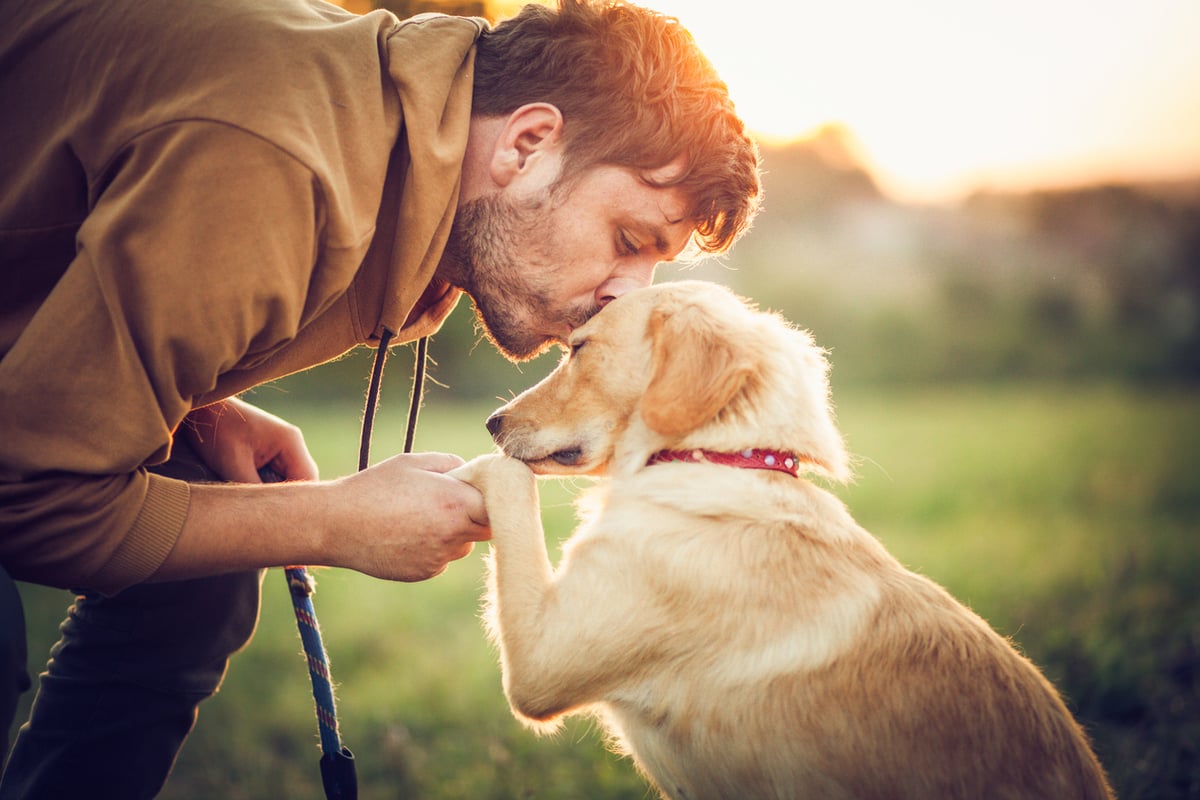
You know how painful a dog torn ACL can be. You also know it can be hard to avoid, but you’ll still try your best to prevent it through the right diet, exercise, and vet visits.
You also know you can both prevent and treat dog torn ACL pain with Integricare’s TRI-ACTA for pets. Offering your dog the best ingredients with no filler, you’ll be able to improve mobility, reduce inflammation, and treat the pain associated with dog torn ACLs.
TRI-ACTA H.A. for Pets
Our maximum strength formula is optimally designed to accelerate the formation of cartilage, minimize inflammation, expedite the healing process, and improve joint conditions.

Learn where you can buy TRI-ACTA, and visit our blog so you can start fighting dog torn ACL pain today.
Newsletter Signup
Subscribe to our newsletter to receive the latest news and exclusive offers.
.jpg?height=2000&name=Cliick_Integricare-DISPLAY-REVISEDV2%20(1).jpg)
Proactive & Therapeutic Joint Supplements
When given daily, Integricare joint supplements recover bone and joint injuries faster and help prevent mobility injuries from happening in the first place.

